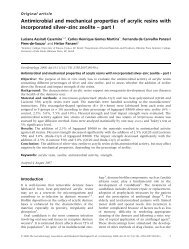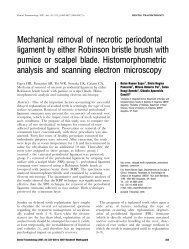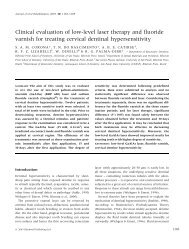Thermoplasticity <strong>of</strong> Gutta-Percha <strong>and</strong> Resilon®M. Tanomaru-Filho et al.Table 1 Endodontic filling materials used in <strong>the</strong> experimental groupsMaterialManufacturerDentsply (conventional<strong>gutta</strong>-<strong>percha</strong>)Dentsply TP (<strong>the</strong>rmoplastic<strong>gutta</strong>-<strong>percha</strong>)Endopoints (conventional<strong>gutta</strong>-<strong>percha</strong>)Endopoints TP (<strong>the</strong>rmoplastic<strong>gutta</strong>-<strong>percha</strong>)Resilon®Dentsply Indústria e Comércio Ltda.,Petrópolis, RJ, BrazilDentsply Indústria e Comércio Ltda.,Petrópolis, RJ, BrazilEndopoints Indústria E Comércio Ltda.,Paraiba do Sul, RJ, BrazilEndopoints Indústria E Comércio Ltda.,Paraiba do Sul, RJ, BrazilPentron Clinical Technologies, Wallingford,PT, USA4.8 kg0.2 kgFigure 1 Apparatus used for <strong>the</strong> test.Glass slabs<strong>the</strong>ir <strong>the</strong>rmoplastic properties (18). As <strong>the</strong>se properties areessential for <strong>the</strong> success <strong>of</strong> numerous root canal fillingtechniques, <strong>the</strong> purpose <strong>of</strong> this study was to assess<strong>the</strong> <strong>the</strong>rmoplasticity <strong>of</strong> <strong>different</strong> commercially availablebr<strong>and</strong>s <strong>of</strong> conventional <strong>and</strong> <strong>the</strong>rmoplastic <strong>gutta</strong>-<strong>percha</strong><strong>cones</strong> compared with Resilon ® syn<strong>the</strong>tic polymer.Materials <strong>and</strong> methodsFor <strong>the</strong>rmoplasticity analysis, five cylindrical specimens(10 mm in diameter, 1.5-mm thick) were made from eachexamined br<strong>and</strong> <strong>of</strong> <strong>gutta</strong>-<strong>percha</strong> or Resilon ® , as describedin Table 1.The material samples were kept in water at 70°C for60 s using a <strong>the</strong>rmometer-controlled heating apparatus(Righetto e Cia., Campinas, São Paulo, Brazil).The heated materials were <strong>the</strong>n placed into st<strong>and</strong>ardisedrings with <strong>the</strong> above-mentioned dimensions, <strong>and</strong>were pressed between two glass slabs under a controlled<strong>and</strong> constant force <strong>of</strong> 0.5 N for 1 min. Thereafter, <strong>the</strong> specimenswere removed from <strong>the</strong> moulds, <strong>the</strong> excess materialwas trimmed <strong>and</strong> <strong>the</strong> dimensions were checked using adigital pachymeter. The specimens were kept at a temperaturebetween 25–30°C for 24 h <strong>and</strong> <strong>the</strong>n returned to <strong>the</strong>heating apparatus at 70°C for 60 s. Next, each sample wasonce again positioned between two glass slabs, <strong>and</strong> a 5-kgweight was placed on top <strong>of</strong> <strong>the</strong> slabs to produce a compressiveforce for 2 min (Fig. 1). Digital images <strong>of</strong> eachspecimen were obtained before <strong>and</strong> after compression,<strong>and</strong> were examined using an image analysis s<strong>of</strong>tware(UTHSCSA Image Tool for Windows version 3.0, SanAntonio, TX, USA) to determine its area. The <strong>the</strong>rmoplasticity<strong>of</strong> <strong>the</strong> materials was determined by <strong>the</strong> differencebetween final <strong>and</strong> initial areas <strong>of</strong> each specimen.The data were analysed statistically by ANOVA, <strong>and</strong> multiplecomparisons among <strong>the</strong> experimental groups weredone by Tukey’s post-hoc test. The significance level wasset at 5%.Figure 2 Means in mm 2 (±SD) <strong>of</strong> <strong>the</strong> differences between initial <strong>and</strong> finalareas <strong>of</strong> each obturation material used in <strong>the</strong> experimental groups. Meansfollowed by <strong>the</strong> same letter did not present statistically significant difference(P > 0.05).ResultsMeans <strong>and</strong> st<strong>and</strong>ard deviation for <strong>the</strong> differences betweeninitial <strong>and</strong> final areas <strong>of</strong> each material are shown inFigure 2. Statistical analysis showed that Resilon ® had <strong>the</strong>highest <strong>the</strong>rmoplasticity means, while Endopoints conventional<strong>gutta</strong>-<strong>percha</strong> had <strong>the</strong> lowest <strong>the</strong>rmoplasticitymeans <strong>of</strong> all tested materials (P < 0.05). Among <strong>the</strong> <strong>gutta</strong><strong>percha</strong><strong>cones</strong>, Endopoints TP (<strong>the</strong>rmoplastic) (EndopointsIndústria E Comércio Ltda., Paraiba do Sul, RJ, Brazil) presented<strong>the</strong> highest <strong>the</strong>rmoplasticity means <strong>and</strong> differedsignificantly from <strong>the</strong> o<strong>the</strong>r commercially available br<strong>and</strong>s(P < 0.05).DiscussionBecause few studies (18,22) have focused on <strong>the</strong> differencesbetween commercially available br<strong>and</strong>s <strong>of</strong> <strong>gutta</strong><strong>percha</strong>,no specific methodology for testing <strong>the</strong> <strong>the</strong>rmoplasticity<strong>of</strong> <strong>gutta</strong>-<strong>percha</strong> has been described. In this study,<strong>the</strong> American Dental Association specification No. 57 (forendodontic sealers) was adapted to <strong>gutta</strong>-<strong>percha</strong> testing.(ISO 6876:2002 – Dental Root Canal Sealing Materials). Toevaluate <strong>the</strong> flowing ability <strong>of</strong> endodontic sealers, a 120-g24 © 2007 The AuthorsJournal compilation © 2007 Australian Society <strong>of</strong> Endodontology
M. Tanomaru-Filho et al. Thermoplasticity <strong>of</strong> Gutta-Percha <strong>and</strong> Resilon®weight is applied. The findings <strong>of</strong> preliminary studiesshowed that <strong>the</strong> force required to provide a significantincrease in <strong>the</strong> diameter <strong>of</strong> heated <strong>gutta</strong>-<strong>percha</strong> specimensshould be greater than 3 kg. In <strong>the</strong> present study, a 5-kgweight was used.In search <strong>of</strong> a better root canal filling, obturation methodsusing heat-s<strong>of</strong>tened <strong>gutta</strong>-<strong>percha</strong> associated with athin layer <strong>of</strong> endodontic sealer have been emphasised(6,25). The lateral condensation method using cold <strong>gutta</strong><strong>percha</strong><strong>cones</strong> may result in voids, which are less likely inwarm <strong>gutta</strong>-<strong>percha</strong> techniques (2,3,25).Resilon ® , a recently launched product, is a syn<strong>the</strong>ticpolymer-based root canal filling material. In <strong>the</strong> presentstudy, Resilon ® had greater <strong>the</strong>rmoplasticity than <strong>the</strong><strong>gutta</strong>-<strong>percha</strong> <strong>cones</strong> (P < 0.05), which supports its claimed<strong>the</strong>rmoplastic properties.According to Schilder et al. (13), <strong>gutta</strong>-<strong>percha</strong> has twoendo<strong>the</strong>rmic peaks. The first peak occurs between 42 <strong>and</strong>49°C <strong>and</strong> corresponds with <strong>the</strong> transformation from <strong>the</strong>beta phase to <strong>the</strong> alpha phase, while <strong>the</strong> o<strong>the</strong>r peak occursbetween 53 <strong>and</strong> 59 o C when <strong>the</strong> material changes from<strong>the</strong> alpha phase to <strong>the</strong> amorphous phase. Miner et al.(22) observed that <strong>the</strong> melting point <strong>of</strong> Resilon ® <strong>and</strong><strong>gutta</strong>-<strong>percha</strong> is 60°C. Combe et al. (17) compared <strong>the</strong>endo<strong>the</strong>rmic peaks <strong>of</strong> non-industrialised <strong>gutta</strong>-<strong>percha</strong> to15 commercially available br<strong>and</strong>s <strong>of</strong> <strong>gutta</strong>-<strong>percha</strong> using<strong>the</strong> temperature <strong>of</strong> 70°C. For <strong>the</strong> dental <strong>gutta</strong>-<strong>percha</strong> formulations,no endo<strong>the</strong>rmic peak occurred at temperatureshigher than 51°C. Venturi et al. (24) investigated threecommercially available br<strong>and</strong>s <strong>of</strong> <strong>gutta</strong>-<strong>percha</strong> in accessorycanals at <strong>different</strong> temperatures, <strong>and</strong> found thatmaterial flow greater than 1.2 mm occurred only at temperatureshigher than 60°C. Based on <strong>the</strong> findings <strong>of</strong> <strong>the</strong>sestudies, a temperature <strong>of</strong> 70°C was chosen for <strong>the</strong> presentstudy.Two <strong>gutta</strong>-<strong>percha</strong> br<strong>and</strong>s were tested in this study. Aconventional <strong>and</strong> a <strong>the</strong>rmoplastic type <strong>of</strong> <strong>cones</strong> <strong>of</strong> eachbr<strong>and</strong> (as specified by <strong>the</strong>ir manufacturers) were used.Both br<strong>and</strong>s are recommended for warm <strong>gutta</strong>-<strong>percha</strong>obturating techniques, especially when <strong>the</strong>rmomechanicalcompactors are used. Among <strong>the</strong> <strong>gutta</strong>-<strong>percha</strong> cone,Endopoints TP showed <strong>the</strong> best <strong>the</strong>rmoplasticity. Conventional<strong>and</strong> TP Dentsply (Dentsply Indústria e ComércioLtda., Petrópolis, RJ, Brazil) <strong>cones</strong> had similar results toeach o<strong>the</strong>r.Gutta-<strong>percha</strong> is a natural polymer that undergoesindustrial processing <strong>and</strong> addition <strong>of</strong> o<strong>the</strong>r substancesbefore its application in dentistry. It has been shown that<strong>the</strong> <strong>the</strong>rmoplastic properties <strong>of</strong> <strong>gutta</strong>-<strong>percha</strong> dependdirectly on its composition, being more pronounced inits pure form than in <strong>the</strong> manufactured version (16).O<strong>the</strong>r studies have reported that <strong>the</strong> amount <strong>of</strong> inorganicfillers added, as well as <strong>the</strong>rmal alterations inducedduring cone manufacture, may affect <strong>the</strong> material’sproperties (15,17,18).The findings <strong>of</strong> a recent chemical <strong>and</strong> X-ray analysis<strong>of</strong> five commercially available br<strong>and</strong>s <strong>of</strong> <strong>gutta</strong>-<strong>percha</strong>showed great variation in <strong>the</strong> amounts <strong>of</strong> zinc oxide (from84.30 ± 0.50% to 66.50 ± 0.50%) <strong>and</strong> <strong>gutta</strong>-<strong>percha</strong> (from14.5 ± 0.70% to 20.4 ± 0.40%). In ano<strong>the</strong>r study involving<strong>the</strong> same br<strong>and</strong>s, to evaluate <strong>the</strong>ir <strong>the</strong>rmoplasticity<strong>and</strong> ability to fill simulated lateral canals, Gurgel-Filhoet al. (18) verified that <strong>cones</strong> with greater percentages <strong>of</strong><strong>gutta</strong>-<strong>percha</strong> provided <strong>the</strong> best results.Although <strong>the</strong> materials evaluated in this study were<strong>different</strong> from those tested by Gurgel-Filho et al. (26), <strong>the</strong>discrepancies in <strong>the</strong> composition <strong>of</strong> <strong>gutta</strong>-<strong>percha</strong> <strong>cones</strong>may explain <strong>the</strong> observed results.The <strong>the</strong>rmoplastic properties <strong>of</strong> Resilon ® are attributedto <strong>the</strong> addition <strong>of</strong> polycaprolactone, which has a meltingpoint <strong>of</strong> 60°C (21). Our results suggest that Resilon ® , presentedto <strong>the</strong> market as an alternative to <strong>gutta</strong>-<strong>percha</strong>, canbe used in <strong>the</strong>rmoplastic techniques <strong>of</strong> root canal obturation,such as <strong>the</strong> hybrid technique proposed by Taggeret al. (4).The present study may be considered as an initial modelfor <strong>the</strong>rmoplasticity evaluation. Fur<strong>the</strong>r research isrequired to increase <strong>the</strong> accuracy <strong>and</strong> st<strong>and</strong>ardisation <strong>of</strong><strong>the</strong> analysis <strong>of</strong> <strong>the</strong> <strong>the</strong>rmoplastic properties <strong>of</strong> <strong>gutta</strong><strong>percha</strong><strong>and</strong> similar root canal filling materials.References1. Schilder H. Filling root canals in three dimensions. DentClin North Am 1967; 11: 723–44.2. Wu M-K, Kastáková A, Wesselink PR. Quality <strong>of</strong> cold <strong>and</strong>warm <strong>gutta</strong>-<strong>percha</strong> fillings in m<strong>and</strong>ibular premolars. IntEndod J 2001; 34: 485–91.3. Jarrett IS, Marx D, Covey D, Karmazin M, Lavin M,Gound T. Percentage <strong>of</strong> canals filled in apical cross sections– an in vitro study <strong>of</strong> seven obturation techniques. IntEndod J 2004; 37: 392–8.4. Tagger M, Tamse A, Katz A, Korzen BH. <strong>Evaluation</strong> <strong>of</strong> <strong>the</strong>apical seal produced by a hybrid root canal filling method,combining lateral condensation <strong>and</strong> <strong>the</strong>rmatic compaction.J Endod 1984; 10: 299–303.5. Peters DD. Two-year in vitro solubility evaluation <strong>of</strong> four<strong>gutta</strong>-<strong>percha</strong> sealer obturation techniques. J Endod 1986;12: 139–45.6. Kontakiotis EG, Wu M-K, WesselinkPR. Effect <strong>of</strong> sealerthickness on long-term sealing ability: a 2-year follow-upstudy. Int Endod J 1997; 30: 307–12.7. Dulac KA, Nielsen CJ, Tomazic TJ, Ferrillo PJ Jr, HattonJF.Comparison <strong>of</strong> <strong>the</strong> obturation <strong>of</strong> lateral canals by six techniques.J Endod 1999; 25: 376–80.8. Goldberg F, Massone EJ, Esmoris M, Alfie D. Comparison <strong>of</strong><strong>different</strong> techniques for obturating experimental internal© 2007 The Authors 25Journal compilation © 2007 Australian Society <strong>of</strong> Endodontology






